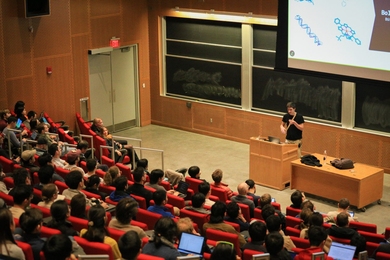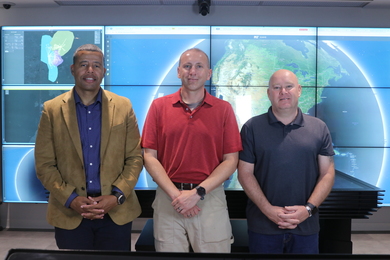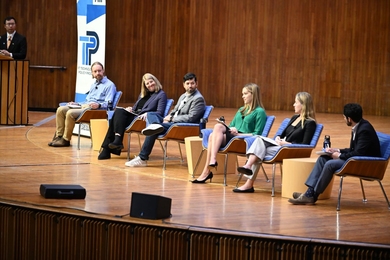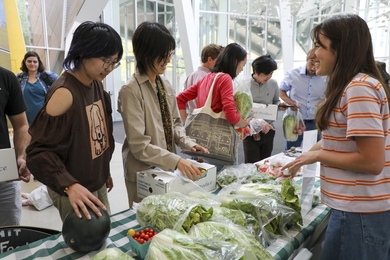Two MIT professors, both well-known authors, have published new books. Dr. Alan Lightman, a physicist who is professor of science and writing and head of the Program in Writing and Humanistic Studies, has produced his second novel, Good Benito (Pantheon), after winning wide acclaim last year for his first, Einstein's Dreams. And Dr. Noam Chomsky, Institute Professor and professor of Linguistics and widely known as a critic of US foreign policy, has written World Orders Old and New (Columbia).
In a review in The Boston Sunday Globe, novelist Carol Anshaw writes that Good Benito "is at its best when illuminating the passionate life of the theoretical physicist, which we don't really understand but assume must be compelling. For a brief moment, we see the beauty of living inside pure notion, unapplied idea, before the flying particles are turned into a toaster oven or thermonuclear device."
Poet and novelist Jay Parini, reviewing Professor Chomsky's book in the Globe, calls it "his best book in many years." In it, he writes, Chomsky examines the Cold War in the half-mil-lenial perspective of his previous book. The results are quite surprising, and bracing. His work leads us to the inescapable conclusion that too much power has fallen into the hands of too few people, yet these people are able to `manufacture consent.'" Jeffrey I. Schiller, network manager for the Distributed Computing and Network Services (Information Systems, has weighed in with an article in Scientific American on "Secure Distributed Computing."
The article asks the question, "Electronic eavesdropping and sabotage threaten the privacy of information passing through computer networks. Short of posting guards over every foot of cable and forcing users to repeat their passwords with each command, how can managers protect their networks?" According to Schiller, a security system developed for the MIT campus offers a model that is convenient-and, so far, impregnable.Dr. Allen J. Cohen, an MIT graduate and professor of radiological sciences at the University of California at Irvine, passes on word that his friend John B. Sanroma, at one time an instrument maker at MIT, recently turned 95 and is still an avid reader of Tech Talk.
Mr. Sanroma, who once made flutes for the Boston Symphony Orchestra, came to MIT during World War II. "Some of his many achievements," writes Professor Cohen, "were in building the camera that Doc Edgerton used to photograph the famous milk drop and building cameras for Jacques Cousteau's underwater expeditions."
Mr. Sanroma for many years was the instrument maker in the Research Laboratory Electronics machine shop in the basement of Building 20, where Professor Cohen got to know him. Professor Cohen received the PhD in physics from MIT in 1970 and worked in RLE from 1965 to 1970. After retiring from MIT at age 70, Mr. Sanroma went to Northeastern University, where he ran the physics department machine shop for 20 years.
Mr. Sanroma and his wife Maude live at 5800 Kiva Lane in Scottsdale, AZ 85253, and would like to receive letters from friends and co-workers, according to Professor Cohen.n Two of MIT's most distinguished black graduates-Dr. Alan Letton and Dr. Lynda Jordan, both currently at historically black universities-are featured in articles in recent publications.
Dr. Letton, who received the SB in chemistry from MIT in 1980, originally thought of a career as a jazz musician, but his academic capabilities carried him to a PhD at the University of Cincinnati in chemical engineering and polymer science in 1984. His next stop was a position with Dow Chemical in Freeport, TX, and then in 1988 to Texas A&M as an associate professor of mechanical engineering. Then, last July, he became dean of the School of Engineering and Architecture at Tuskegee University. His story, written by Michael J. Major, and replete with instances of racism throughout his career, appeared in the Career Development Guide.
Dr. Jordan came out of one of Boston's toughest housing projects to receive the PhD in biological chemistry at MIT in 1985 and a prestigious fellowship at the Institut Pasteur in Paris, France. She is now an internationally known biochemist at North Carolina A&T and will be featured in an upcoming Public Broadcasting System series on female scientists. Her story, by B. Denise Hawkins, appeared in the December issue of Black Issues in Higher Education.CLIPSMore often than not, when MIT faculty members talk to the press, their comments are likely to be compressed into a sentence or two. Dr. Bernard J. Frieden, professor of city planning and associate dean of architecture and planning, may have had the ultimate experience when he was interviewed by The Wall Street Journal for a story on the proliferation of aquariums in big cities as tourist attractions.
"I said a number of substantive things about why cities are building aquariums these days," notes Dr. Frieden, "but what the reporter quoted was an off-hand comment."
The actual quote: "Suddenly everyone is interested in fish."
Dr. Frieden, an old hand at being interviewed by the media, took it all in stride and found it quite humorous.
A version of this article appeared in MIT Tech Talk on February 1, 1995.





